Hand, Wrist, and Elbow

FORM Ortho offers conservative, non-surgical treatments to the latest state-of-the-art surgical procedures for hand, wrist, and elbow conditions. Patients of all ages and activity levels are seen for simple or complex conditions.
Hand and Wrist
Our hands are vital for many everyday activities during work and leisure. To do these activities, our hands require sensations and movements such as joint motion, tendon gliding, and muscle contraction. When a problem takes place in the hand, attention must be given to all the different types of tissues that make functions of the hand possible.
Hand surgery is the field of medicine that deals with problems of the hand, wrist, forearm, elbow, & bicep. Hand surgeons care for these problems with and without surgery. They devote their time to examining, treating, and studying hand and upper-extremity ailments, and are specially trained to operate when necessary.
Elbow
The elbow joint is made up of three bones: the humerus or upper arm bone, the paired radius, and the ulna. The biceps (or upper arm muscles) and the triceps (or lower arm muscles) are responsible for moving the elbow hinge. Elbow injuries are not only common with sports such as tennis, golf, and mountain climbing, but also with any activity that requires repetitive arm movement.
Hand Conditions
Your hands are constantly in motion and therefore vulnerable to injury. Repetitive motion or overuse injuries such as tendonitis (inflammation of the tendons) are among the most common hand conditions. Your hands can also be affected by normal wear and tear on the joints, resulting in arthritis.
The following are just a few of the common hand conditions. If you are experiencing pain or discomfort in your hands or fingers, or have additional concerns, contact our office for an appointment.
Wrist Conditions
Because your hands are constantly in motion, that means your wrists are too. Your wrists are susceptible to repetitive motion and overuse injuries as well such as carpal tunnel syndrome and tendonitis. Your wrists will usually suffer injury when your hands are used as a form of protection during a fall, which can result in wrist fractures and injuries involving ligaments, tendons, and nerves. A hand surgeon should be consulted to care for these conditions especially with wrist fractures that can have complications with healing.
The following are just a few of the common wrist conditions. If you are experiencing pain or discomfort in your wrists, or have additional concerns, contact our office for an appointment.
- De Quervain’s Tenosynovitis
- Ganglion Cysts
- Distal Radius Fracture
- Scaphoid Fracture
De Quervain’s Tenosynovitis
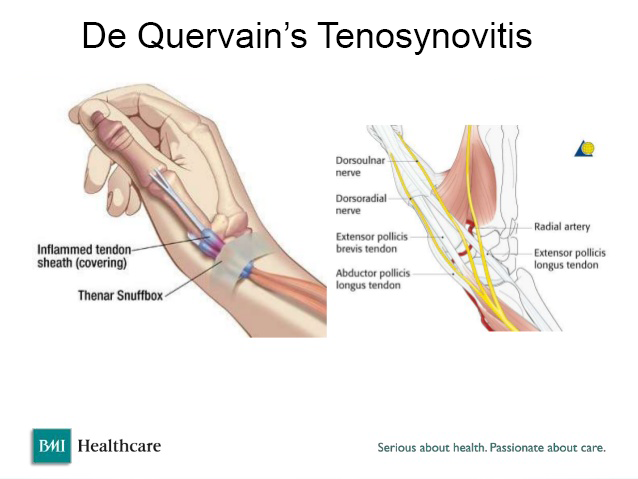
De Quervain’s tenosynovitis is tendonitis that is caused by overuse of the wrist next to the thumb. The overuse causes inflammation of the tendons between the thumb and the wrist. When the tendons move through the tunnels, the inflammation can cause numbness and tingling. Common symptoms of De Quervain’s tenosynovitis include tenderness, pain, and weakness of the thumb and wrist. Patients with symptoms of De Quervain’s tenosynovitis complain of pain during normal activities including writing, typing, and any simple thumb movement. Treatment for De Quervain’s tenosynovitis includes wrist splinting and physical therapy. If those treatments do not improve symptoms, then cortisone injections and/or minimally invasive surgery can treat De Quervain’s tenosynovitis.
Ganglion Cysts
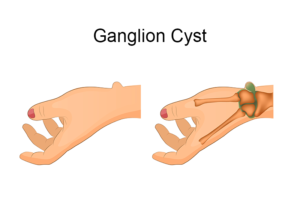
Ganglion cysts are bumps that occur on the hand and wrist. The lumps are noncancerous swellings that arise when synovial fluid leaked from the joints or tendons and forms a cyst on the hand. Symptoms of ganglion cysts may include hand and wrist pain and/or pressure, disfigurement of the hand, and difficulty with hand and wrist movement. Ganglion cysts will either disappear on their own over time or get bigger. If ganglion cysts get bigger, they may cause pressure and/or pain in the wrist or hand which means that they will have to be removed using a needle aspiration or minimally invasive surgery. It is important to get ganglion cysts checked out by your doctor if symptoms and pain worsen over time.
Distal Radius Fracture
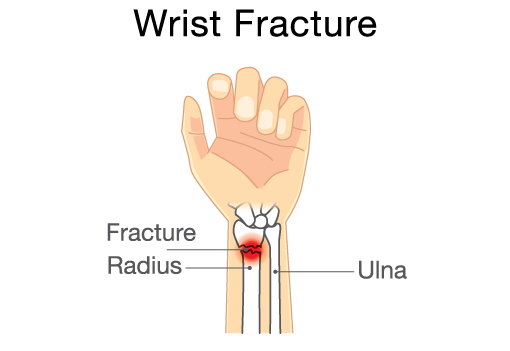
The radius is the larger of the two bones in the forearm. The smaller bone is called the ulna. The part of the radius closest to the wrist is called the distal radius. A distal radius fracture usually occurs as the result of a fall on an outstretched hand and usually results in pain, swelling, and bruising of the affected limb. Sometimes there is gross deformity with the wrist hanging in an odd position. There are several different classifications of distal radius fractures and it is important to identify which type to determine the treatment needed. Treatment will vary not only based on the type of fracture but severity as well. Treatments can be nonsurgical and needing only a cast to surgical intervention.
Scaphoid Fracture
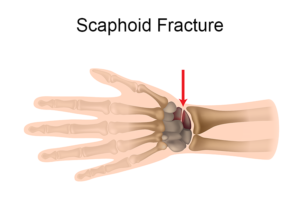
The wrist is formed by the two bones of the forearm, the radius and the ulna, and eight small carpal bones. The carpal bones are arranged in two rows at the base of the hand. There are four bones in each row. The scaphoid bone is one of the carpal bones on the thumb side of the wrist, just above the radius. A scaphoid (navicular) fracture is a break that occurs most often after a fall onto an outstretched hand. Symptoms of a scaphoid fracture typically include pain and tenderness in the area just below the base of the thumb. These symptoms may worsen when you try to pinch or grasp something. Treatment for a scaphoid fracture can range from casting to surgery, depending on the severity and location of the fracture. Because portions of the scaphoid have a poor blood supply, a fracture can disrupt the flow of blood to the bone and complications with the healing process can occur. Therefore, it is important to consult a hand surgeon as soon as possible.
Elbow Conditions
Many things can make your elbow hurt. A common cause is tendinitis, an inflammation or injury to the tendons that attach muscle to bone. Tendinitis of the elbow can be a sports injury, often from playing tennis or golf. You may also get tendinitis from overuse of the elbow. Other causes of elbow pain include sprains, strains, fractures, dislocations, bursitis, and arthritis. Treatment depends on the cause, so it is important to consult a doctor who specializes in upper extremity conditions to get the right diagnosis and treatment.
The following are just a few of the common elbow conditions. If you are experiencing pain or discomfort in your elbow, or have additional concerns, contact our office for an appointment.
- Cubital Tunnel Syndrome
- Lateral Epicondylitis (Tennis Elbow)
- Medial Epicondylitis (Golfer’s Elbow)
Cubital Tunnel Syndrome
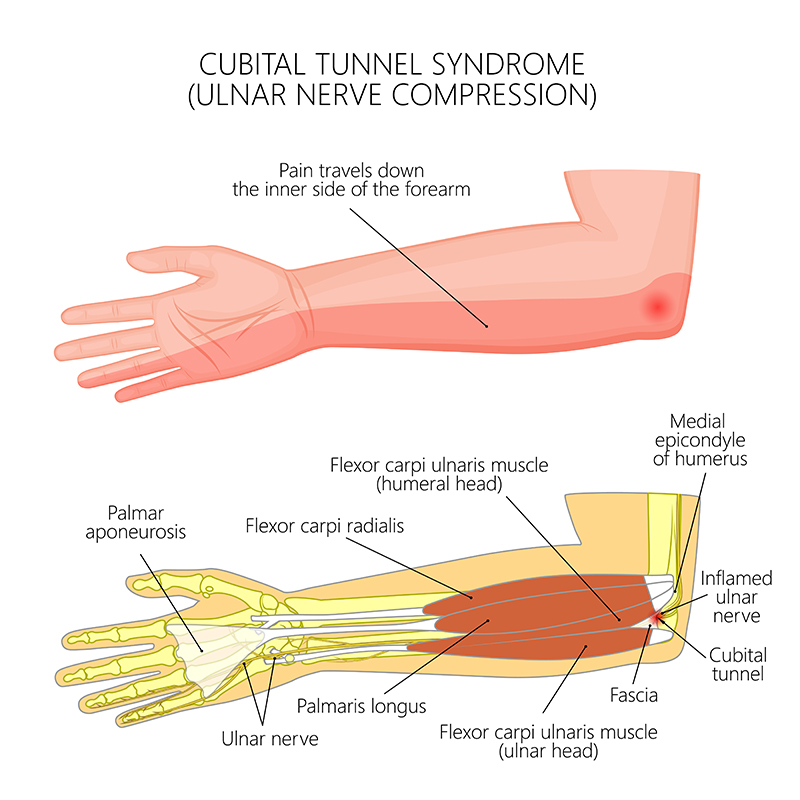
Cubital tunnel syndrome is caused when the ulnar nerve in the elbow is compressed. The ulnar nerve, commonly known as the ‘funny bone,’ runs through the cubital tunnel in the elbow which is comprised of bone and tissue. When the tissue is swollen due to overuse or repetitive use, the blood supply can be aggravated which then causes the symptoms for cubital tunnel syndrome. Symptoms for cubital tunnel syndrome include elbow pain and/or stiffness, loss of strength in the hand, pain and tingling in the fingers, and numbness in the fingers. It is important to seek treatment for cubital tunnel syndrome as over time, the nerve damage can become permanent if symptoms go untreated. Treatment for cubital tunnel syndrome includes elbow splinting or padding and anti-inflammatory medication. If those treatments do not work, cortisone injections or minimally invasive surgery may be recommended.
Tennis Elbow
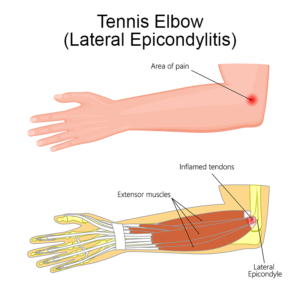
Tennis elbow or lateral epicondylitis is a tendonitis of the outside of the elbow, unlike golfer’s elbow which affects the inside of the elbow. Tennis elbow is mainly caused by repetitive use during tennis or any other activity that uses the hand or wrist muscles. These muscles share a common tendon that is connected to the portion of the elbow bone known as the lateral epicondyle. Tiny tears happen over time and with age, the body has a more difficult time repairing itself which leads to symptoms of tennis elbow. Symptoms of tennis elbow or lateral epicondylitis include pain while bending the wrist, tenderness or pain in the elbow, difficulty picking up heavy objects, and weakness in the hand and wrist. When the pain and/or weakness is interfering with your daily activities, it is time to seek tennis elbow treatment from an orthopedic hand specialist such as Dr. Besh. Treatment for tennis elbow includes physical therapy, stretching, rest, and/or anti-inflammatory medication. If the symptoms of tennis elbow persist with the above treatment then cortisone injections and minimally invasive surgery are other options for tennis elbow.
What is tennis elbow?
Golfer’s Elbow
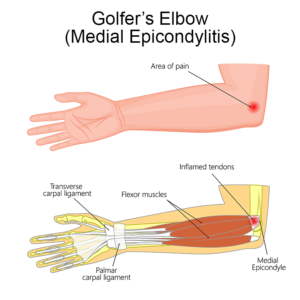
Medial epicondylitis or golfer’s elbow is tendonitis of the inside of the elbow joint. The repetitive overuse of these muscles causes inflammation of the tendons, the connective tissue between the muscle and the bone. While golf is a common cause of medial epicondylitis, it can also be caused by any repetitive motion or sharp sudden movement that involves the elbow. Common symptoms of golfer’s elbow include pain at the inside of the elbow, elbow stiffness, numbness or tingling in fingers, and hand and/or wrist weakness. Treatment of golfer’s elbow can include physical therapy, anti-inflammatories, splinting, and stretching. In some cases, cortisone injections may be suggested when other treatments are not effective. In the case of golfer’s elbow, surgery is rarely an option, but the best way to know for sure is to schedule an exam with a physician who specializes in hand, wrist and elbow conditions.
What Is Golfer’s Elbow?
Contact Us
Whether your hand, wrist, or elbow condition is urgent as a result of an injury, painful because of overuse, or keeping you from doing everyday things, we welcome you to our practice.
Dr. Basil Besh is a board-certified orthopedic surgeon specializing in Hand, Wrist, and Elbow conditions. He is one of the few hand surgeons in Silicon Valley that has the Subspecialty Certificate in Surgery of the Hand and has over 15 years of experience focused on orthopedic hand conditions.
Dr. Besh is an expert in his field in both surgical and non-surgical interventions. He provides thorough and accurate diagnoses and recommends the best treatment for your condition to assure maximal recovery.
You may request an appointment by calling our office at (510) 857-1000 to get started. We offer same-day or next-day appointments.
